Quite often, women experience the appearance of dark spots on their face over time. As long as they are small in size, they do not cause trouble. But over time, they can take up most of the face. Why do age spots appear on the face of women?
What is a pigment spot
Pigment spots are an accumulation of the natural dye melanin in a limited area. The color of a person's hair and skin depends on the amount of melanin produced by the body.
Most often, such spots appear after 40 years. But they can appear at any age. Most often, hyperpigmentation forms in areas of the skin exposed to sunlight.
There are several types of age spots. Some are disturbing, others are not.
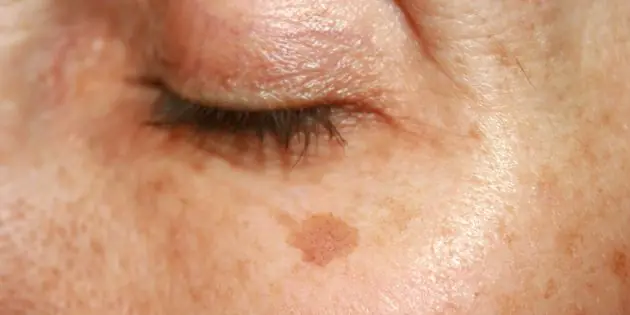
Types of age spots
| Name | Description | Reason for appearance |
|---|---|---|
| Freckles, or ephelides | Small round spots from light brown to dark brown. | They can occur under the influence of ultraviolet radiation in blondes and brown-haired women. |
| Lentigo (age spots) | The spots are oval in shape and reach a size of 20 mm. | They can form when exposed to the sun for a long time on the arms, face, and shoulders. More often they form after 35 years in place of freckles. |
| Nevus, or birthmark | They can be both small and large. | May occur in infancy. |
| Melasma | Large pigment spots without clear boundaries. | They are formed against the background of a hormonal disorder under the influence of the sun. |
Important! The more a girl is exposed to the sun in her youth, the stronger and more pigment spots will appear in adulthood.
Causes of age spots
The appearance of age spots is due to many reasons.
The main causes of pigmentation on the face in women are:
- Solar radiation. Melanin contains vitamin D3 in its structure. This vitamin is naturally synthesized under the influence of ultraviolet radiation. It is at the moment of irradiation that melanin is produced and colors the skin. Over time, the skin loses its ability to restore its color, and melanin is distributed unevenly throughout the skin.
- Hormone production. During pregnancy, menopause or taking contraceptives, the hormonal background of the female body changes. As a result, age spots may appear.
- Diseases of internal organs. The appearance of pigment spots may indicate diseases of the kidneys, liver, and endocrine system.
- Skin damage. The skin reacts to any damage by producing melanin. A pigmented spot may appear at the site of a minor abrasion or removed acne.
- Frequent use of peeling increases melanin production.
- Lack of vitamins C and PP in the body.
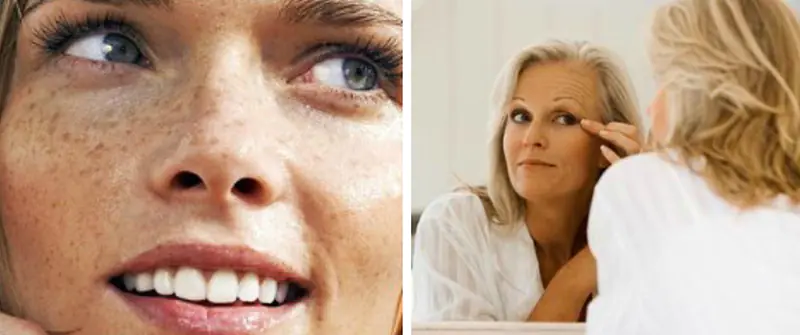
Causes of age spots on the face
Important! To prevent the appearance of age spots after cleansing the skin using chemical peeling, apply a cream with SPF 30 or 50 to the skin.
Ways to eliminate age spots
Although the reason for the appearance of pigment spots on the face of women is different, it does not interfere with the body’s activity and only causes visual discomfort, many want to get rid of them.
Important! Under the influence of ultraviolet light, skin cells can degenerate into cancerous ones. The appearance of age spots warns of the possibility of such a change.
To remove excess pigmentation, there are both hardware and cosmetic methods.
The first include:
- Phototherapy. Accumulations of melanin are destroyed using high-intensity pulsed light. The procedure is performed by a cosmetologist.
- Selective laser. A special laser that creates an ultrashort pulse destroys cells with a high melanin content.
- Skin cleansing with glycolic acid. This procedure is called chemical peeling. It is also performed by a cosmetologist.
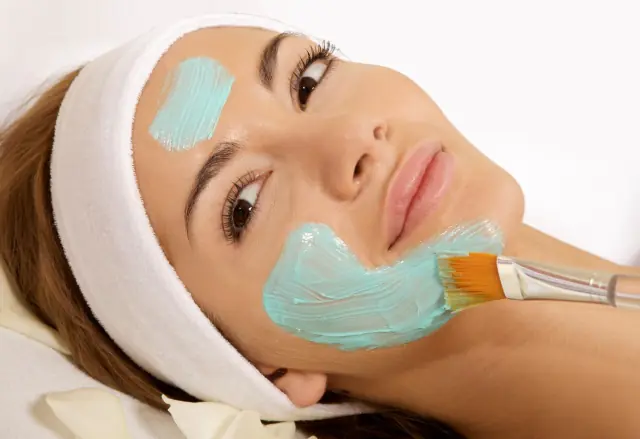
Glycolic peeling for facial cleansing
Cosmetic methods are more gentle and are aimed at suppressing the production of tyrosine. It is on its basis that melanin is formed.
Such substances include:
- Kojic acid. It whitens the skin and removes dead particles from it.
- Arbutin. It is used in combination with kojic acid, as it enhances the whitening effect. It was found in bearberry and blackberry.
- Ascorbic acid. Reduces the formation of melanin and at the same time increases the formation of collagen.
- Glabrin. Has anti-inflammatory and whitening effects.
With slight pigmentation, it may be enough to change your diet. Increasing your diet with citrus fruits, currants, grapes, bell peppers, as well as other fruits and vegetables containing vitamin C in large quantities will speed up the skin lightening process.
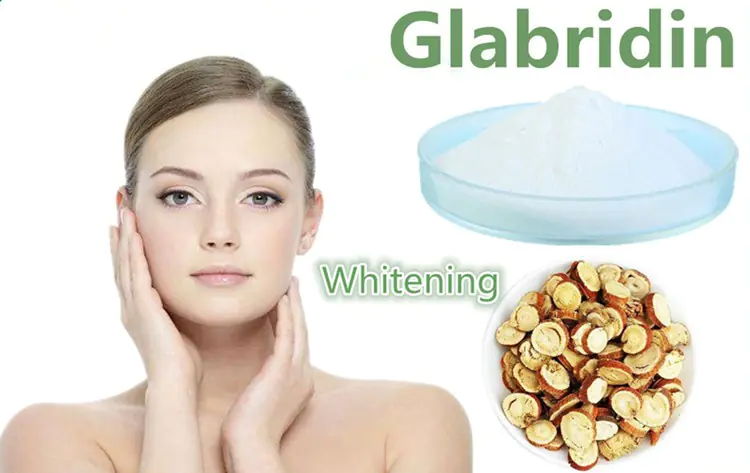
Glabrin for face
Further skin care for women
Due to the fact that yellow spots on the face in women appear from the sun, the best prevention of hyperpigmentation is protection from it. Women prone to high melanin production should use creams with sun protection factor.
Important! You should choose a cream that contains protection against UVB and UVA rays.
Prevention and home care for skin prone to pigmentation are based on the use of cosmetics that accelerate skin restoration and reduce melanin production. These products lighten the skin.
For whitening, you can use products available to every woman.
Here are some recipes for skin whitening at home:
- Wash with settled water with the addition of lemon, onion or parsley juice. Juice should be taken at the rate of 1 tbsp. l. per glass of water.
- Masks made from fresh vegetables and fruits will help not only reduce pigmentation, but also improve skin nutrition.
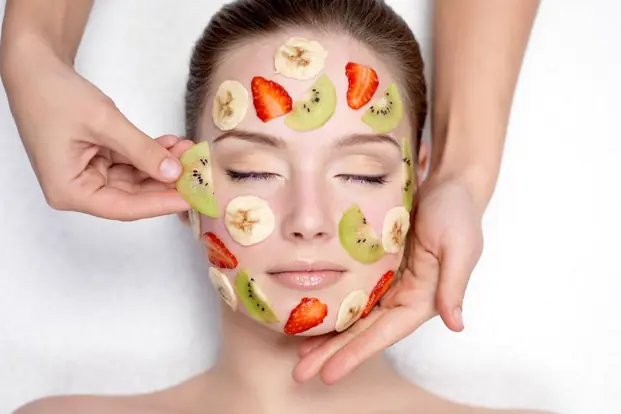
Fresh fruit masks
Suitable for masks:
- Tomatoes;
- Bell pepper;
- Cucumber;
- Currant;
- Strawberry.
- Hydrogen peroxide mask. Beat one egg white and add 1 tbsp. l. peroxide. Mix well and apply to face. After 20-30 minutes, the mask can be removed.
- White clay mask. You can buy it at the pharmacy. Clay powder is diluted with water or fruit juice. Apply to face for 15-20 minutes.
- Yeast mask.
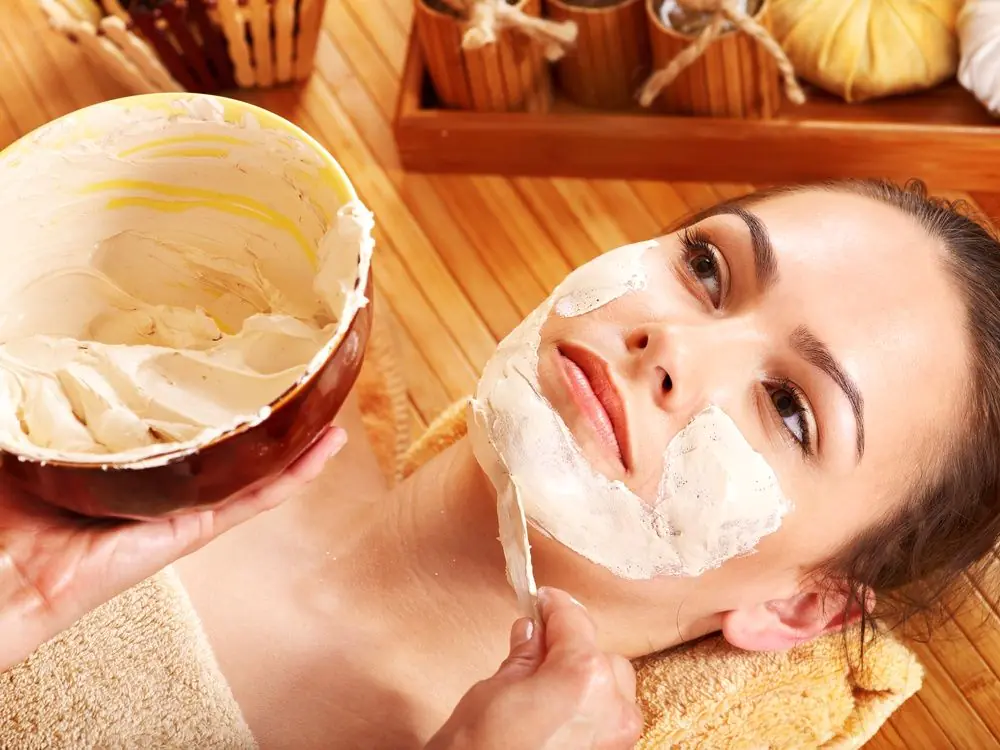
Rejuvenating yeast facial mask
To prepare it you will need:
- 20 gr. brewer's yeast;
- 1 tsp. lemon juice;
- 1 tsp. grapefruit juice.
Mix everything thoroughly and apply to the face. Keep the mask on for 20 minutes, then rinse with warm water.
- Cabbage mask. Grind the white cabbage in a meat grinder, add a tablespoon of honey and mix. Apply to face for 20 minutes.
- Extract the juice from the cabbage and freeze. Wipe your skin with the resulting ice in the morning.
Advice from doctors and cosmetologists
There are many skin whitening products available in the market these days. However, cosmetologists do not recommend lightening it yourself. Only an experienced cosmetologist will select the procedure and products that best suit your skin type and the characteristics of age spots.
According to cosmetologists, at the early stage of pigmentation, creams containing substances such as vitamin C, hydroquinone and arbutin will be effective. The most important criterion when buying a cream is the presence of a sun protection factor in the composition.

Important! Whitening at home should be done with caution. Since the main substances used for home skin whitening contain acid, you need to be careful with them. They can easily cause burns and, as a result, hyperpigmentation.
Cosmetologists talk about using both professional and home remedies to combat melanin. They complement and strengthen each other.
When prescribing medications, you should find out whether they contribute to the production of melanin.
Important! You should use any products at home after consulting a specialist.
After 60 years, age spots become larger and less treatable. That is why cosmetologists advise limiting sun exposure at any age.
The appearance of age spots is not a death sentence. With the help of modern hardware techniques, special creams and home remedies, age spots can be reduced. In rare cases, specialists may recommend surgery to remove an area of severe pigmentation. But these are already extreme measures.
You should use sunscreen, sunbathe in the morning or evening, then your skin will delight you with its whiteness for many years.
We name the main reasons for the appearance of age spots, and at the same time learn to distinguish banal freckles from “senile buckwheat”, prevent hyperpigmentation and fight it if it has already appeared.
- What are pigment spots
- Causes of pigmentation
- Types of pigmentation
- Methods for eliminating age spots
- Cosmetic ingredients effective against pigmentation
- Prevention of hyperpigmentation
- Fighting pigmentation at home
What are pigment spots
Pigment spots are darkened areas of the skin that appear as a result of a local accumulation of the melanin pigment, which gives color to the skin and hair. The size, shade, and number of spots can vary: from a scattering of golden freckles to single dark brown areas.
Age spots can appear at any age, in people with different skin colors and types. Everyone is susceptible to them:
representatives of the first phototype - fair-skinned blonds with gray or blue eyes who do not tan well and quickly get sunburned;
representatives of dark phototypeswho have an increased tendency to hyperpigmentation, especially after inflammatory processes or with hormonal imbalance.
Causes of pigmentation
To fight pigment spots, or better yet, prevent them, you need to have an idea of the culprits behind their appearance.
Ultraviolet
The main provocateur of the formation of age spots is the sun. And even if problems with pigmentation are programmed genetically, UV rays will be the very trigger that will manifest these problems.
Ultraviolet radiation damages cells, causing protective reactions, as a result of which the activity of melanocytes is activated (they produce pigment). Melanocytes intensively produce melanin. And it is deposited unevenly in the skin, especially in places of greatest photodamage.
As a result, spots appear on the prominent parts of the face—on the nose and cheekbones—that become darker with age.
Hormones
Often the reason for the appearance of age spots on the face in women is associated with hormonal changes against the background of:
When the body returns to normal life, pigment problems disappear, although there are exceptions. Then you will need the help of an endocrinologist who will identify the cause, and a cosmetologist who will find a way to eliminate the consequences.
Ultraviolet light provokes hyperpigmentation © iStock
Diseases
Hyperpigmentation may indicate problems with the liver, kidneys, endocrine system disorders and gynecological diseases. In such cases, cosmetic procedures are necessary, but it is more important to focus efforts on treating the underlying disease.
Mechanical skin damage
“Anything that violates the integrity of the epidermal barrier - wounds, burns, abrasions - often becomes the cause of pigment spots, because in response to damage, melanin synthesis increases,” says Alexander Prokofiev, an expert at the Ls Roche-Posay brand. Therefore, cosmetic procedures such as chemical peels and dermabrasion are recommended not to be carried out during periods of solar activity, and after them it is necessary to apply a cream with SPF 30 or 50.
Types of pigmentation
Pigment spots differ in size, shade, color saturation. Their only common property is their “love” for the sun: most often they are found on areas of the skin exposed to ultraviolet radiation.
Freckles (ephelids)
These are small spots of a round shape, uniform color, with a diameter of 1-2 mm. As a rule, they appear with active exposure to ultraviolet radiation on the skin of the face, body and hands of blondes, brown-haired and red-haired people unprotected from the sun.
The more intense the sun exposure, the darker the freckles. Without the support of the sun, they turn pale, and in winter they may disappear completely until the next season.
Lentigo (solar lentigo)
Larger than freckles, oval-shaped spots with a diameter of 2-20 mm. Located where the skin is more exposed to UV rays:
Their color is usually uniform, the pigmentation is persistent and does not disappear on its own. Lentigines are also called “age spots” because they appear in adulthood, often in the same places where freckles were in youth.
The older a person is, the more extensive, dark and difficult to remove the spots become. This is how areas damaged by ultraviolet radiation throughout life make themselves felt.
Birthmark (nevus)
The most common type of age spots. Almost everyone has them, even babies. Nevi can appear at any age, but are especially active in adulthood.
Melasma (chloasma)
Large pigment spots that do not have a clear shape. Most often they appear on the face, their number increases under the influence of the sun. The main reason is hormonal changes. If they are temporary (pregnancy, lactation), then melasma may disappear after the hormonal levels return to normal.
Methods for eliminating age spots
Phototherapy is an effective hardware procedure against age spots © iStock
Age spots do not always cause problems for their owners. In youth, freckles look charming and are not considered a flaw. Another thing is that when they become brighter and larger, their number increases and does not decrease even in winter. Melasma, islands of accumulated pigment, also causes concern.
High-intensity pulsed light destroys the accumulation of melanocytes. The doctor prescribes the number of flashes and sessions individually depending on the depth of the pigment and its quantity.
A laser with an ultrashort pulse finds cells with a high content of melanin and literally crushes it into small particles.
A good lasting result can be achieved by a course of peelings with glycolic acid, which renews the skin, in combination with home cosmetics that suppress the production of melanin.
Consequences of hyperpigmentation
Pigmentation problems are often associated with age-related changes © iStock
Pigment spots themselves are not dangerous to health. But this is a signal that ultraviolet radiation has already damaged the skin, and should not be ignored. The sun can trigger the process of cell degeneration and become a provocateur of irreversible changes.
Cosmetic ingredients effective against pigmentation
In cosmetic formulas, whitening ingredients reduce the synthesis of tyrosine, a precursor to melanin.
Kojic acid - one of the AHA acids, has a whitening and exfoliating effect.
Arbutin - a plant component found in bearberry and blackberry. In combination with kojic acid, it enhances the whitening effect.
Ascorbic acid (vitamin C) - a powerful antioxidant and reducing agent. It is easily destroyed, so magnesium salt of L-ascorbic acid is often used in cosmetics, which turns into vitamin C in the skin. Reduces melanin synthesis and enhances collagen synthesis.
Glabridin - licorice root extract. It has not only a whitening, but also an anti-inflammatory effect.
Return to contents
Prevention of hyperpigmentation
There is no better preventative measure than sun protection. If you are prone to hyperpigmentation, use products with a high protection factor. Ideally, every day, even in cloudy weather, because type A UV rays, which enhance pigmentation, penetrate even through clouds and window glass.
The right sunscreen contains filters against UVB and UVA rays, contains caring components and antioxidants, and also has a comfortable texture.
Below are some effective high SPF sunscreens.
Contains a special complex to prevent hyperpigmentation.
Designed for very fair skin, suitable for face and body.
Anti-aging care 3-in-1 with antioxidants Capital Idéal Soleil, SPF 50, Vichy
Protects from the sun, not only prevents the manifestations of skin aging, but also specifically fights them.
Fighting pigmentation at home
Home care for skin affected by age spots includes creams and serums that can influence the functioning of melanocytes and renew the skin to lighten the spots.
Remedies against age spots
complex of four multidirectional acids, yeast extract
Not only the physical health, but also the psychological state of a person depends on the condition of the skin and its appearance. Pigment spots, especially on open areas of the body, can cause a lot of inconvenience to a person, no matter what age he is. But you shouldn’t consider a pigmentation disorder as just an annoying aesthetic problem - in some cases, a pigment spot may be a signal that it’s time to go to the hospital and undergo a full examination. In order to preserve youth and health of the skin for a long time, you need to know why the production of pigments is disrupted and how to permanently get rid of age spots on the face.
What is a pigment spot?


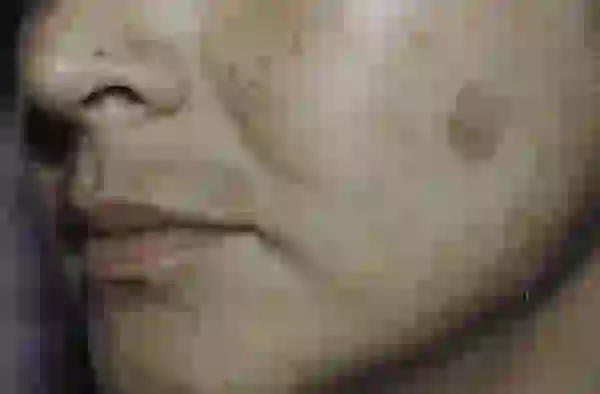
In a healthy person, special cells - melanocytes - constantly synthesize the pigment - melanin. This substance determines the color of hair, skin and eyes. Also, normally, the production of melanin is enhanced by ultraviolet radiation - a bronze tan appears on the skin. But sometimes, under the influence of environmental factors, as well as pathological processes that occur inside the body, the normal production of melanin is disrupted, which leads to the appearance of age spots on the face.
A pigment spot is a limited area of skin in which hyperpigmentation or hypopigmentation is observed. Hyperpigmentation is caused by excessive synthesis of melanin, hypopigmentation is caused by a decrease in the intensity of this process. Pigmentation disorders can manifest themselves in various diseases of internal organs, and can also be a consequence of already suffered dermatological diseases.
Why do age spots appear on the face?
The face is that part of the body that is constantly under the influence of negative factors. This is why pigmentation disorders most often develop on the face. Experts identify a number of reasons why age spots develop on the face. These include:
- exposure to ultraviolet rays. As already mentioned, under the influence of ultraviolet radiation, the skin becomes darker, as melanin synthesis increases. However, with prolonged exposure to direct sunlight, as well as with frequent visits to the solarium, pigment spots appear on the skin - this is a protective reaction of the body.
- genetic predisposition to hyperpigmentation. Heredity also plays a very important role. Doctors note that in children whose parents suffer from age spots, the risk of their occurrence increases several times.
- hormonal imbalances and chronic diseases of internal organs. Often pigment spots on the face are a signal that one or another pathological process is occurring in the body (this could be diseases of the stomach, liver, intestines or gall bladder). Also, pigmentation on the face often appears during endocrine diseases and when hormonal levels change: during pregnancy and lactation, during puberty, during menopause.
- improper skin care. If skin care products and decorative cosmetics are chosen incorrectly, this can lead to the appearance of age spots on the face.
- environmental factors. Changes in temperature and humidity, excessive friction and squeezing of the skin can also disrupt metabolic processes in the layers of the epidermis - as a result, melanocytes begin to actively synthesize pigment.
- stress and emotional overload. The state of the nervous system can also indirectly (through its effect on hormones) affect the condition of the skin. With chronic stress and fatigue, the protective functions of the skin decrease and it becomes more susceptible to physical and mechanical stress.
- insufficient intake of vitamins and minerals. Minerals and vitamins, like hormones, can influence the quality and speed of reactions that occur in the body. Therefore, if they are deficient, there is a high probability of developing areas of hyperpigmentation on the face.

Pigment spots after acne
Young girls especially often face this problem. If acne, furunculosis, and other dermatological diseases are not treated correctly, there is a risk of developing pigment spots on the face. The more damaged the skin is, the more likely it is that areas of hyperpigmentation, or white spots, will appear on the face.
Pigmentation in dry skin
Dry skin is thinner and more sensitive to various environmental factors. Therefore, pigmentation occurs more often in those people who have dry, fair skin.
Localization and features of age spots on the face
Excessive pigmentation can appear on any part of the face. Most often, age spots can be seen on the nose, cheeks, eyelids, around the mouth and on the chin, sometimes the forehead and even the ears are affected. They can be located either singly (nevi) or in the form of clusters (which is typical for chloasma, solar lentigo and freckles). If excessive pigmentation occurs as a result of perioral dermatitis, then pigment spots will be located around the lips. After suffering periorbital dermatitis, you can notice pigmentation around the eyes, on the forehead, bridge of the nose and cheekbones. The color can also vary from dark beige to red, dark brown and even black (for example, when nevi occur).
What types of age spots most often appear on the face?
As already mentioned, the face is the part of the body that is more susceptible to the appearance of age spots than others. Pigmentation disorders are typical for the following conditions: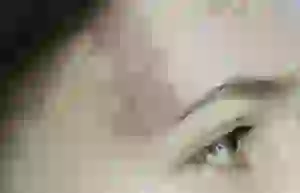
- freckles or ephelides. These are small spots whose color can vary from dark beige to orange or brown. They usually occur on the cheeks, but can spread to other parts of the face, as well as the arms and shoulders. People with fair skin are prone to the appearance of freckles. In most cases, ephelides appear in the spring (under the influence of ultraviolet radiation), and by autumn they go away on their own. But sometimes there are cases when freckles can be noticed on the skin in any season.
- lentigo. There are 3 types of this disease: juvenile (or juvenile) lentigo, senile lentigo and solar lentigo. Juvenile and senile lentigo is associated with changes that occur in the body - these are hormone fluctuations and changes in skin type. Solar lentigo is directly dependent on ultraviolet radiation. Pigment spots in these conditions are located in groups, their color may differ.
- chloasma. These are pigment spots that appear as a result of endocrine system disorders, and often during normal changes in hormone levels (during pregnancy or menopause, after stopping oral contraceptives).
- nevi (birthmarks, moles). Often these pigment spots appear in the prenatal period of development, as well as in the first years of life. They can be of different sizes and colors, localization also differs in each specific case. In most cases, they are convex and rise above the surface of the skin.
- vitiligo. This is a disease in which white spots appear on the skin. Vitiligo often appears on the skin of the extremities, but sometimes this process can also be seen on the face. Scientists have not fully studied the mechanism of occurrence of this disease, but most of them are inclined to believe that melanocytes in vitiligo are destroyed under the influence of antibodies that are “erroneously” produced by the immune system.

Sometimes pigmentation disorders can also occur after other dermatological diseases, and can also be a sign of fungal skin infection (for example, with pityriasis versicolor).
What symptoms may be a reason to seek medical help?
In most cases, patients with age spots on the face are not bothered by physical discomfort. The only complaint may be the presence of an area of hyperpigmentation or hypopigmentation, which primarily causes psychological discomfort. Approximately 95% of age spots are absolutely safe for health and do not pose any threat to the body.
If there is a pigment spot (or several) on your face, you need to remain calm and simply observe their development over time. Doctors recommend conducting a visual examination of the skin of the face; this should be done once every 2-4 weeks. In this case, each time it is necessary to record all the data about the area where excess pigmentation is observed. It is necessary to record what size and color the spot is, what edges it has, whether it is symmetrical, and how it develops. One of the following 5 signs may be a reason to urgently consult a doctor:
- the birthmark is more than 6-7 mm in diameter;
- the color is uneven or has changed;
- edges are fuzzy, uneven;
- asymmetry of the neoplasm;
- the pigment spot increases rapidly.
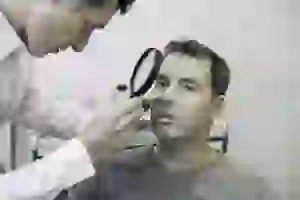
It is very important to consult a doctor if one of the above signs appears, because it may indicate the initial stage of melanoma (skin cancer).
What studies and tests are needed for diagnosis?
Pigment spots are often a sign of a skin disease, so it should be diagnosed and treated by a dermatologist. But sometimes consultations with other specialists are also required: gynecologist, endocrinologist, gastroenterologist, neurologist, therapist. This is necessary in order to make sure that there are no other pathologies on the part of the internal organs. Diagnostics takes place in several stages:
- Initial appointment with a dermatologist. During it, the doctor communicates with the patient, finds out his complaints, collects an anamnesis of life and illness, as well as family and allergy history. During a conversation with the patient, the doctor will find out how long ago the age spot appeared, how it developed, what could have triggered its occurrence (according to the patient), and whether there have been similar cases in the family. After this, the doctor conducts an examination: assesses the number of pigment spots, their color, size, and location.
- Making a preliminary diagnosis. It is carried out on the basis of data obtained during questioning and inspection. The preliminary diagnosis determines what examinations the patient needs to undergo.
- Additional studies (instrumental and laboratory): dermatoscopy, general blood test, biochemical blood test, general urine test, biopsy, bacteriological examination of skin smears.
- Making a final diagnosis. It is carried out on the basis of all the information received. Depending on the final diagnosis, the patient is recommended the necessary therapy that will help cure age spots.

Treatment methods for age spots on the face: drug and hardware therapy, cosmetics, folk remedies
Removing age spots is a fairly lengthy process that requires some effort. The main principle of getting rid of age spots is to identify and eliminate the cause that led to this condition. In order to remove existing age spots, the following bleaching agents are used:
- A 3% solution of hydrogen peroxide, which should be applied only to the area where pigmentation is observed. Hydrogen peroxide can irritate the skin and dry it out, so be sure to consult a doctor.
- preparations containing mercury. They are effective in whitening skin, but are sold by prescription only and should be used under the supervision of a specialist.
- ointments, pastes and creams with zinc. This is one of the safest ways to remove age spots on your face. Use with caution for people who have dry and flaky skin - zinc can aggravate this condition.

Therapeutic cosmetics with a brightening effect: what to look for when purchasing
Whitening creams and masks are very popular. To date, hundreds of such products have been developed, but they contain one of the following substances:
- topical retinoids;
- kojic acid;
- hydroquinone;
- licorice root extract;
- mequinol;
- niacinamide;
- azelaic acid.
The advantage of medicinal cosmetics is that it normalizes melanin synthesis, thereby reducing the likelihood of developing new age spots.
It must be remembered that medicinal cosmetics should be selected together with a dermatologist and cosmetologist. It is also necessary to carefully read the instructions for use and study the composition. Under no circumstances should you buy imported cosmetics whose instructions have not been translated into Russian - they may contain harmful chemical compounds and even topical steroids. It is important to always check quality certificates and order medicinal cosmetics on official websites or buy in pharmacies.
Traditional methods of treatment
Alternative medicine is good because it is accessible, inexpensive, has a small number of contraindications and side effects, and helps with treatment in childhood and adolescence. The most effective folk remedies for age spots are masks and lotions using the following ingredients:

There are a large number of recipes online using these products, but you should always remember that traditional medicine has not been tested by dermatologists, so it may cause some side effects. Before using any method of alternative medicine, it is mandatory to consult your doctor and conduct an allergy test. To do this, you need to apply a small amount of the resulting product to the skin and observe its condition for 20-30 minutes. The most effective recipes in this article.
Basic methods of hardware therapy that will help remove age spots
For several decades now, hardware medicine has been a leader in terms of effectiveness in the fight against excessive pigmentation. Currently, the following methods of hardware cosmetology are used:
- removal of pigment spots with laser;
- cryotherapy (exposure to liquid nitrogen);
- chemical peeling;
- phototherapy;
- mechanical cleaning.
These procedures are aimed at exfoliating dead cells, starting and accelerating regeneration processes. By removing the upper layers of the epidermis, age spots are also removed. The disadvantage of these treatment methods is that they only help remove pigment spots on the face that exist, but do not in any way affect the impaired synthesis of melanin - the cause of hyperpigmentation. Methods of hardware treatment of age spots should also be agreed with a doctor, because many of them have a number of contraindications.
Prognosis and possible complications
Since 95% of age spots are safe, the prognosis is favorable. However, you need to remember the risk of complications. Sometimes the cells in a birthmark become malignant, leading to the development of skin cancer (melanoma). Melanoma is one of the most dangerous types of cancer; it develops quickly, is difficult to treat and metastasizes even to the most distant organs.
In order to avoid this complication, you need to undergo regular examinations with a doctor or independently monitor the condition of birthmarks. At the first sign of an enlargement or other change in the birthmark, you should urgently seek medical help!
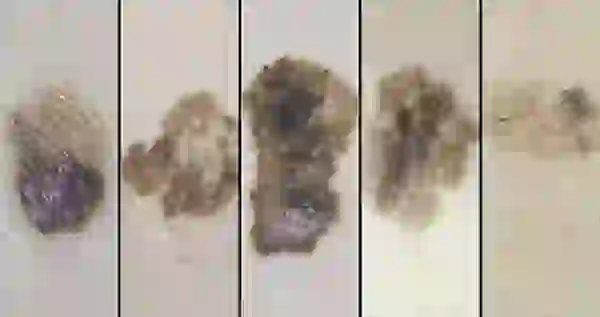
How to avoid the appearance of age spots on the face?
The skin of the face is very thin and vulnerable, so you need to take enough measures to protect it from the effects of negative environmental factors. To avoid the appearance of pigmentation disorders on the face, doctors recommend:
- limit the time spent under the influence of ultraviolet rays (beach, solarium). Under no circumstances should you sunbathe during periods of increased solar activity: 11-15 hours of the day. People with fair skin should follow this recommendation especially carefully.
- Be sure to use sunscreen. It is better to choose natural, hypoallergenic creams with an SPF filter of more than 40.
- decorative cosmetics and care products should be chosen only of high quality. You can also use cosmetics that are designed for skin prone to hyperpigmentation (for example, there are foundations and makeup bases that also protect against UV rays).
- monitor your health: regularly undergo preventive examinations with a therapist;
- avoid stress and unnecessary stress on the body;
- use all medications (tablets, injections, ointments) only under the supervision of a doctor;
- if other skin diseases occur, do not self-medicate - this can aggravate the condition and lead to the appearance of hyperpigmentation;
- protect skin from exposure to heat, cold and wind;
- eat a balanced diet, eat more vegetables and fruits in season.
Pigment spots can cause psychological discomfort, so they can and should be dealt with. Thanks to modern technologies, you can permanently clear your face of age spots in just a few months.
| Product name | Action | Active Ingredients |
| Highly effective anti-pigmentation cream-care Advanced Pigment Corrector, Skinceuticals | Renews the skin, helps correct hyperpigmentation and prevent its reappearance. |



